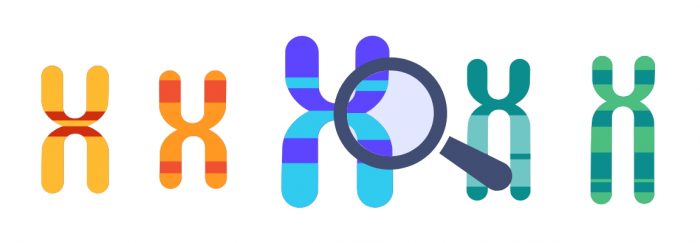Ancestry DNA tests provide information about the possible origin of the individual’s ancestors undergoing the genetic test. This is done by comparing the person’s genetic material with reference populations known for their geographic origin and ethnicity.
The key lies in specific genetic variants, in most cases, SNPs (single nucleotide polymorphisms). These are changes in the individual’s DNA sequence in ONE single base, one single nucleotide (although sometimes changes of a few nucleotides are included under this term). They must also meet another condition: this genetic variation must be present in at least 1 out of every 100 individuals. If not, it is considered a point mutation without other nicknames.
Technically, SNPs are still point mutations, but they are point mutations found in many individuals and have endured over time. This is the part that’s interesting in ancestry studies. They are passed down stably over generations, so some SNPs are specific to world regions and ethnicities.
Does a SNP reveal your origin? No. But if we work with thousands of SNPs, the situation changes. By comparing the SNPs an individual has against databases with hundreds of thousands of people from different areas and populations, their origin can be determined by parallels in DNA variants.
It sounds like a long and complicated task, but companies like ours have refined algorithms specialized in the process. Algorithms whose purpose is precisely to compare, find, and calculate similarities.
The study of human gene ancestry is an ongoing and cumulative process. As the number of populations studied increases, so will the knowledge of past events and the ability to refine our studies of the past. Ancestry studies become more reliable.
Our report, for example, shows in percentage form the genetic composition allocation in the various ethnic groups considered, organized by their geographical location. In general, geographically closer populations tend to have higher genetic affinities.

Our ancestors define us
Knowing where we come from is more important than being a trivial fact. Various studies have shown that many health conditions or vulnerability of individuals and populations to certain diseases or infectious agents are conditioned by gene ancestry.
For example, sickle cell anemia, named for its sickle-shaped red blood cells, instead of their usual round shape. It is a disease caused by a mutation with a gene that provides an advantage: affected individuals are resistant to malaria. As a result, the disease is more common in people with ancestors from endemic malaria regions.
Another example is thalassemia, another type of hereditary anemia. This disease is common in Mediterranean regions. Two regions stand out: Apulia and Sardinia. In just under 7 million inhabitants, it is estimated that 700,000 people are affected by the pathology.
If we shift from regions to ethnicities, perhaps the most studied group are the Ashkenazi Jews. Within this ethnicity, 1 in 27 individuals carries Tay-Sachs disease. Outside this ethnicity, carriers are estimated at 1 in 250 individuals.
Not all are diseases; other genetic traits are also conditioned by our ancestors. Lactose intolerance in Arabs, Africans, Latinos, or Asians affects over 80% of the population. However, in Northern Europe, less than 5% of people in these groups have an intolerance to this compound. Interestingly, this makes lactose tolerance the exception in humans, not the norm.
Going into detail, haplogroups
We can’t talk about ancestors without mentioning haplogroups. A haplogroup is a large group of haplotypes. Which doesn’t provide much more clarity.
A haplotype can be simply defined as a combination of SNPs on the same chromosome that are usually transmitted together. And many different haplotypes form a haplogroup. In humans, there are two haplogroups studied:
- Maternal or mitochondrial haplogroup. What’s special about it? All mitochondria are inherited from the mother. Sperm leave their mitochondria behind, and the fetus develops from those in the egg, so all an individual’s mitochondria come from the maternal side.
- Paternal or Y-chromosome haplogroup. What’s special? Only males have a Y chromosome, while females are XX. Therefore, an individual can only inherit his Y chromosome from the paternal side.
Thanks to having DNA that we know unequivocally comes from a certain parent, and because haplotypes are combinations of SNPs that are transmitted together, we can trace back generations into our father’s and mother’s family histories separately.
Lineages would trace back to the so-called Y-chromosomal Adam and Mitochondrial Eve, each being the original Y chromosome and mitochondrion from which we all descend. Our most ancient common ancestors.
Today, studies continue on the various haplogroups, their phylogenetic relationships, geographic distributions, migrations, and past. For example, the original mitochondrial haplogroup was named L, with L0 to L6 within Africa, the initial continent, before migrations to other continents. However, the first humans to leave Africa, from group L3, gave rise to haplogroups M (which would arise in India) and N, the main group in current Europe.
In conclusion, genetic ancestry tests allow those interested in their family history to obtain complementary information to what they might find from relatives or historical documentation. In these cases, we recommend a completed ancestry DNA test, like ours.
This information is useful in many fields, from individual health and personalized medicine to the study of human migrations throughout history. Or simply because you want to know, which is as good a reason as any. And you, do you want to know?



